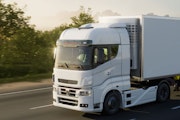5 ways to focus on safety with GPS fleet tracking
For businesses that rely on vehicles and drivers to keep things running, safety is everything. Learn how GPS tracking...
Read more
Just as you’re getting out your winter jackets and boots and starting to think about the holidays, it’s the perfect time to prepare your fleet for what’s in store during the coldest months of the year. Dark nights and inclement weather make for more treacherous roads, while lower temperatures can impede peak fuel efficiency and cause extra maintenance issues for your vehicles.
Here are just a few reasons the winter months can be particularly hard on fleet-based businesses:1
While winter weather can hinder productivity and increase risks on the road and on the job, being proactive is a fleet’s best defense.
Monitoring the health of your vehicles is critical at all times and is especially key during the winter months. Make sure to keep an eye on any active diagnostic trouble-code (DTC) alerts, including engine functions like:
This data can help get vehicles into service before a major repair is needed or a breakdown occurs—which can be a very dangerous situation during the winter.
It’s important to find the right preventative maintenance schedule that works for your fleet. Miles traveled, engine hours, fuel usage and calendar time are the typical guides. If you also track the number of breakdowns, jumpstarts, tows and emergency repairs, you might see patterns that require adjustments to your maintenance schedule. For fleets with a lot of vehicles operating over a wide area, tracking service records using fleet management software can provide more effective control and efficiency.
Telematics also allows you to examine your drivers’ winter driving performance, so you can offer important feedback and coach safe driving habits.
Remind fleet drivers to exercise more caution while traveling in winter conditions, reduce their speed and not follow cars too closely. Quick acceleration and harsh cornering can also cause issues in winter conditions. Should a driver encounter black ice or slippery snowy roads, and their vehicle starts sliding, they must remember to turn into the skid. They should additionally proceed with extra caution in winding mountain terrains and over bridges which tend to freeze first.
Reducing distracted driving is a critical part of keeping drivers and others on the road safe while also protecting your company's reputation and bottom line. Talking about these safety topics helps them become an integral part of company culture and helps reinforce the importance of eliminating distracted driving behaviors.
In-cab video integrated into your telematics solution is especially useful for a holistic picture of driving events. With optional dual view of the driver and the road, this video evidence can be used in the event of a serious driver infraction, aid in accident investigations and determine liability.
A handy winter checklist for your managers and drivers can go a long way to prioritizing winter safety. This can be kept in the glove compartment and referred to whenever temperatures drop.
Your checklist should include instructions on how to:
Your winter checklist should also include instructions detailing what to do in the event of a breakdown as well as a list of emergency contacts.
With a little extra preparation, you can help keep your drivers safe, warm and moving this winter. A fleet management solution can help keep your vehicles in peak condition and prioritize your drivers’ safety.
For more information, download our free ebook 4 Ways Telematics Can Improve Fleet Maintenance, or schedule a demo today.
1 https://ops.fhwa.dot.gov/weather/weather_events/snow_ice.htm
Tags: Data & Analytics, Performance & Coaching, Safety, Team Management




Find out how our platform gives you the visibility you need to get more done.
For businesses that rely on vehicles and drivers to keep things running, safety is everything. Learn how GPS tracking...
Read more7 Secrets to a Safe Fleet
Read more4 Ways Telematics Can Improve Fleet Maintenance
Read moreWith the consistent increase in stops and idle time, the regular issues of fuel wastage, wear and tear, and dangerous...
Read more